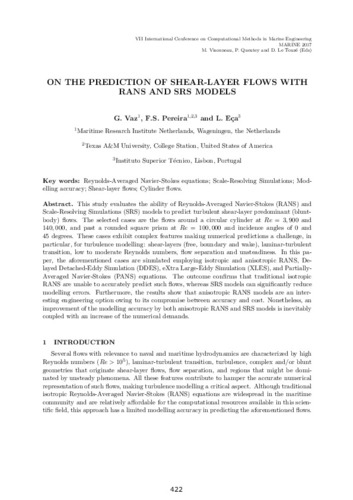On the prediction of shear-layer flows with rans and SRS models

Visualitza/Obre
Estadístiques de LA Referencia / Recolecta
Inclou dades d'ús des de 2022
Cita com:
hdl:2117/331873
Tipus de documentText en actes de congrés
Data publicació2017
EditorCIMNE
Condicions d'accésAccés obert
Tots els drets reservats. Aquesta obra està protegida pels drets de propietat intel·lectual i
industrial corresponents. Sense perjudici de les exempcions legals existents, queda prohibida la seva
reproducció, distribució, comunicació pública o transformació sense l'autorització del titular dels drets
Abstract
This study evaluates the ability of Reynolds-Averaged Navier-Stokes (RANS) and
Scale-Resolving Simulations (SRS) models to predict turbulent shear-layer predominant (blunt- body)
flows. The selected cases are the flows around a circular cylinder at Re = 3, 900
and 140, 000, and past a rounded square prism at Re = 100, 000 and incidence angles
of 0 and 45 degrees. These cases exhibit complex features making numerical predictions a
challenge, in particular, for turbulence modelling: shear-layers (free, boundary and wake),
laminar-turbulent transition, low to moderate Reynolds numbers, flow separation and
unsteadiness. In this pa- per, the aforementioned cases are simulated employing
isotropic and anisotropic RANS, De- layed Detached-Eddy Simulation (DDES), eXtra Large-Eddy
Simulation (XLES), and Partially- Averaged Navier-Stokes (PANS) equations. The outcome
confirms that traditional isotropic RANS are unable to accurately predict such flows, whereas
SRS models can significantly reduce modelling errors. Furthermore, the results show that
anisotropic RANS models are an inter- esting engineering option owing to its compromise
between accuracy and cost. Nonetheless, an improvement of the modelling accuracy by both
anisotropic RANS and SRS models is inevitably
coupled with an increase of the numerical demands.
CitacióVaz, G.; Pereira, F.S.; Eça, L. On the prediction of shear-layer flows with rans and SRS models. A: MARINE VII. "MARINE VII : proceedings of the VII International Conference on Computational Methods in Marine Engineering". CIMNE, 2017, p. 422-439. ISBN 978-84-946909-8-3.
ISBN978-84-946909-8-3
| Fitxers | Descripció | Mida | Format | Visualitza |
|---|---|---|---|---|
| Marine-2017-32_ ... diction of shear-layer.pdf | 9,985Mb | Visualitza/Obre |

